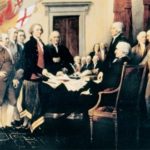In the Constitution, Congress is charged with providing for the general welfare of the country’s
citizens. Historically, this has meant improving transportation, promoting agriculture
and industry, protecting health and the environment and seeking ways to solve social and
economic problems. In 1956, Congress passed the Federal-Aid Highway Act, popularly known as the National Interstate and Defense Highways Act, authorizing federal funding for the extension and
construction of a robust network of interstate highways. This project was one of the largest public
works in U.S. history establishing key transportation infrastructure that impacted lives of all
Americans — changing communities, access and economic possibilities and also providing key
routes for evacuating urban centers — a critical national defense issue in the Cold War era.
Analyzing primary source material, students discuss the origins and reasons for the National
Interstate and Defense Highways Act. Then, they work with historical and contemporary maps
as they consider the impact this important congressionally funded project. While intended for 8th
grade students, the lesson can be adapted for other grade levels.
Juneteenth General Order
In this activity, students will carefully analyze General Order 3 from Major General Gordon Granger which informed the people of Texas that “all slaves are free.” This activity is appropriate as a conclusion to the Civil War and the beginning of Reconstruction.
The Purposes of Government
This lesson has students learn about the purposes of government specified in the preamble of the Constitution. Students will use C-SPAN video clips to define what is meant by “establish Justice, insure domestic Tranquility, provide for the common defense, promote the general Welfare, and secure the Blessings of Liberty.” As practice, students will apply their knowledge of these purposes by viewing real-life examples of government actions and identifying the relevant purpose of government. This lesson works well in classrooms with one-to-one devices and can be adapted to flipped classrooms.
Constitutional Index – General Welfare Clause
The Constitutional Index breaks down the U.S. Constitution by Section, Amendment, and Clause and contains broader topics and themes. These are used to cross-reference Library resources in an effort to annotate constitutional history.
Constitutional Index – Promote the General Welfare Clause
The Constitutional Index breaks down the U.S. Constitution by Section, Amendment, and Clause and contains broader topics and themes. These are used to cross-reference Library resources in an effort to annotate constitutional history.
The Electoral College
Today, the American people vote for president and vice president on Election Day. But, technically speaking, these votes don’t directly determine the outcome of the election. These popular votes determine which electors will be appointed to the Electoral College, which is made up of 538 electors drawn from the states and the District of Columbia. Each state is granted a different number of electoral votes based on the size of its congressional delegation. The electors meet after the general election to cast their votes for president and vice president.
Jury Service: Our Duty and Privilege as Citizens
In America, the responsibility to protect individual rights and promote the common good ultimately rests with its citizens, not the government. When citizens participate in thoughtful and responsible ways, the welfare of our constitutional democracy is ensured. While most civic participation is voluntary, the call to serve on a jury is not. It comes as an order by the court.
No Vehicles in the Park
In this lesson, students will apply a general law – “no vehicles in the park” – to specific circumstances in considering the language of the law and its intended objective. The task will require that they interpret the law to allow for certain circumstances – an ambulance carrying a dying patient, for example. The lesson ends with students rewriting the law to more clearly reflect the intent of the lawmakers.
Realizing the Dream Today
Students will analyze a political cartoon depicting Dr. Martin Luther King Jr. and the title of his famous speech, “I Have a Dream.” Discussion of the meaning of the cartoon leads into a more general conversation about rights and equality.
What Fundamental Ideas About Government Do Americans Share?

In this lesson, you will examine some of the fundamental ideas about government that are contained in the Declaration of Independence and the Preamble to the U.S. Constitution. When you have completed this lesson, you should be able to explain those ideas and identify which ideas the class holds in common. If you support these ideas, you will be given an opportunity to go online and add your signature to those of the Founders of our nation who signed the original documents.